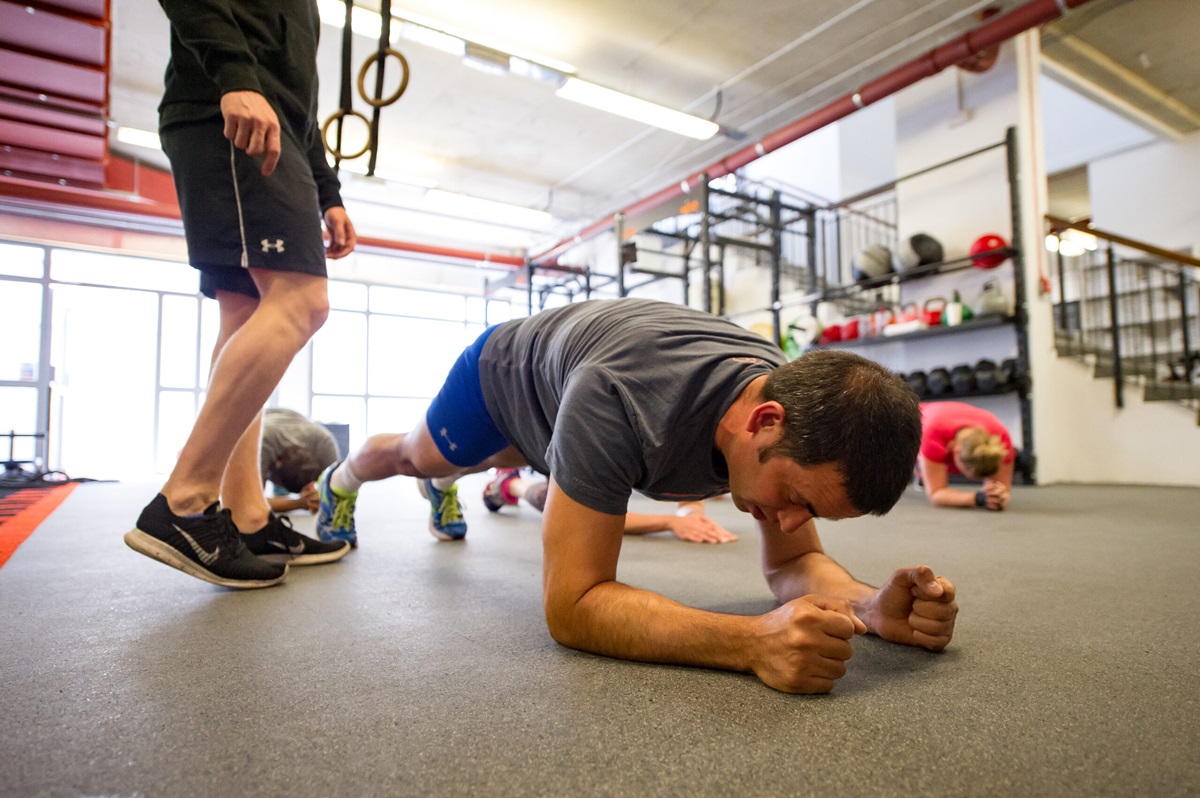

Featured
How To Lower Heart Rate With Exercise
Modified: January 22, 2024
Learn how exercise can help lower your heart rate and improve your cardiovascular health. Discover the featured techniques to effectively manage your heart rate through fitness.
Introduction
When it comes to our health, there is one vital organ that keeps our body functioning – the heart. The heart rate, which refers to the number of times the heart beats per minute, plays a crucial role in maintaining overall cardiovascular health. However, in today’s fast-paced world, many individuals face the challenge of having a high resting heart rate, which can indicate potential heart problems or a lack of physical fitness.
Lowering the heart rate is not only important for individuals with existing heart conditions but also for anyone looking to improve their overall health and well-being. Fortunately, one effective method of achieving a lower heart rate is through exercise.
In this article, we will explore the benefits of lowering heart rate and discuss the various types of exercises that can help achieve this goal. Whether you are a fitness enthusiast or someone who is simply looking to improve their heart health, this comprehensive guide will provide you with the information you need to lower your heart rate through exercise.
Understanding Heart Rate
Before we dive into the various exercise strategies for lowering heart rate, it’s important to understand what heart rate is and why it matters for our overall health.
The heart rate is the number of times your heart beats per minute (BPM). It is a measure of the efficiency and effectiveness of your cardiovascular system. A normal resting heart rate typically ranges from 60 to 100 BPM, but it may vary depending on factors such as age, fitness level, stress level, and overall health.
A high resting heart rate can be an indication of various underlying health conditions, such as hypertension, cardiovascular disease, or poor physical fitness. On the other hand, a lower resting heart rate generally reflects a better cardiovascular health and higher level of fitness.
Lowering your heart rate has numerous benefits. It not only helps to improve cardiovascular health, but it also reduces the risk of heart disease, stroke, and other chronic illnesses. Additionally, a lower heart rate promotes better recovery after exercise and allows the body to efficiently deliver oxygen and nutrients to the muscles.
Regular exercise plays a key role in maintaining a healthy heart rate. By engaging in physical activity, you can condition your heart to become more efficient, resulting in a lower resting heart rate. Let’s explore the different types of exercises that can help achieve this goal.
Benefits of Lowering Heart Rate
Lowering your heart rate through exercise provides a myriad of benefits that contribute to overall health and well-being. Let’s explore some of the key advantages:
- Improved Cardiovascular Health: Regular exercise that lowers the heart rate strengthens the heart muscle and improves its efficiency. This reduces the risk of cardiovascular diseases such as heart attacks, stroke, and high blood pressure.
- Increased Fitness Level: Lowering your heart rate is a sign of improved cardiovascular fitness. With regular exercise, your heart becomes stronger and more efficient in pumping blood throughout the body. This results in reduced fatigue, increased stamina, and improved endurance.
- Better Recovery: Maintaining a lower heart rate during exercise promotes quicker recovery. It allows the body to efficiently remove metabolic waste products such as lactic acid and replenish oxygen and nutrients to the muscles. This means you’ll experience less muscle soreness and fatigue after workouts.
- Stress Reduction: Lowering your heart rate has a positive impact on your mental health as well. Exercise releases endorphins, which are natural mood enhancers, helping to reduce stress, anxiety, and symptoms of depression.
- Weight Management: Engaging in exercises that lower the heart rate can aid in weight management. By burning calories and boosting metabolism, these exercises contribute to maintaining a healthy weight or achieving weight loss goals.
- Longer Life Span: Studies have shown a correlation between lower resting heart rate and increased life expectancy. Lowering your heart rate through exercise can potentially add years to your life.
- Better Sleep: Regular exercise can promote better sleep by regulating your sleep-wake cycle and reducing sleep disturbances. Lowering your heart rate through exercise can help you achieve a more restful and rejuvenating night’s sleep.
With these incredible benefits in mind, let’s explore the different types of exercises that can help lower your heart rate.
Types of Exercise for Lowering Heart Rate
When it comes to lowering your heart rate through exercise, there are several types of exercises to consider. Each type offers unique benefits and contributes to improving cardiovascular health. Let’s take a closer look:
- Cardiovascular Exercise: Cardiovascular exercises, also known as aerobic exercises, are great for lowering the heart rate. Activities such as brisk walking, jogging, swimming, cycling, and dancing get your heart pumping while challenging your cardiovascular system. Aim for at least 150 minutes of moderate-intensity aerobic exercise or 75 minutes of vigorous-intensity exercise per week.
- Strength Training: While strength training may initially elevate your heart rate, it can lead to lowered resting heart rate in the long term. Resistance exercises, such as lifting weights or using resistance bands, strengthen muscles and improve overall fitness. Aim for two or more strength training sessions per week, targeting major muscle groups.
- Yoga and Meditation: Yoga and meditation focus on deep breathing, relaxation, and mindfulness. These practices can effectively lower heart rate and reduce stress levels. Incorporating yoga and meditation into your exercise routine can help you achieve a state of calmness and improve heart health.
It’s important to combine different types of exercise in your fitness routine to reap maximum benefits. Additionally, listening to your body and finding activities that you enjoy will increase your motivation to stick with your exercise regimen.
Now that we’ve explored the types of exercises for lowering heart rate, let’s delve into some specific tips to keep in mind during your workouts.
Cardiovascular Exercise
Cardiovascular exercise, also known as aerobic exercise, is a powerful way to lower heart rate and improve overall cardiovascular health. This type of exercise elevates your heart rate during the activity, which strengthens your heart, improves lung function, and enhances blood circulation. Here are some popular cardiovascular exercises that can help you achieve a lower heart rate:
- Brisk Walking: Walking is a low-impact exercise that is accessible to most people. By increasing your pace to a brisk walk, you can elevate your heart rate and improve cardiovascular fitness. Aim for at least 30 minutes of brisk walking most days of the week.
- Jogging/Running: Running or jogging is a more intense form of cardiovascular exercise that can significantly lower your heart rate over time. Start with shorter distances or intervals and gradually increase your running duration as your fitness improves.
- Swimming: Swimming is a full-body workout that provides a low-impact, joint-friendly exercise option. Whether you swim laps or participate in water aerobics classes, swimming effectively strengthens the heart and improves cardiovascular endurance.
- Cycling: Cycling, whether outdoors or on a stationary bike, is an excellent cardiovascular exercise that engages the large muscles in your legs. It can be enjoyed at various intensities, ranging from leisurely rides to high-intensity interval training (HIIT).
- Dancing: Dancing is a fun and engaging way to increase your heart rate while enjoying music and movement. Whether you join a dance class or have a dance party in your living room, this aerobic activity provides cardiovascular benefits and helps lower your heart rate over time.
Remember to start slowly and gradually increase the duration and intensity of your cardiovascular exercise. Consistency is key – aim for at least 150 minutes of moderate-intensity aerobic exercise or 75 minutes of vigorous-intensity exercise per week.
In the next section, we’ll explore the role of strength training in lowering heart rate and improving overall health.
Strength Training
While cardiovascular exercise is essential for lowering heart rate, incorporating strength training into your fitness routine offers additional benefits. Strength training not only helps build muscle and increase overall strength but also contributes to lowering heart rate in the long term. Here are some key points about strength training:
- Muscle Strengthening: Strength training exercises, such as lifting weights or using resistance bands, target specific muscle groups and improve their strength. This enhanced muscular strength can reduce the workload on the heart, resulting in a lower heart rate.
- Improved Body Composition: Strength training increases muscle mass and boosts metabolism, which can aid in weight management. Maintaining a healthy weight is important for overall heart health and can contribute to a lower heart rate.
- Better Overall Fitness: As your muscular strength increases, performing tasks and activities become easier, requiring less exertion from your heart. This leads to a lower heart rate during everyday activities and exercise.
- Increase in Resting Metabolic Rate: Strength training stimulates your metabolism, allowing your body to burn calories even at rest. A higher resting metabolic rate can lead to weight loss or maintenance and overall heart health improvement.
- Bone Health: Strength training exercises, like weightlifting, help improve bone density and reduce the risk of osteoporosis. Stronger bones contribute to overall physical fitness and can support a healthier cardiovascular system.
When incorporating strength training into your fitness routine, aim for at least two sessions per week. Work on different muscle groups on separate days and allow for adequate rest in between workouts.
It’s important to note that strength training may cause a temporary increase in heart rate during the actual exercise due to the physical exertion involved. However, over time, the cardiovascular system adapts and becomes more efficient, resulting in a lower heart rate even during strength training sessions.
In the next section, we’ll explore the calming benefits of yoga and meditation in lowering heart rate.
Yoga and Meditation
Yoga and meditation offer unique approaches to lower heart rate by combining physical movement, deep breathing techniques, and mindfulness practices. These practices promote a sense of calmness and relaxation, which can have a positive impact on heart health. Here’s what you need to know:
- Deep Breathing: Yoga and meditation emphasize deep, controlled breathing. This type of breathing activates the parasympathetic nervous system, also known as the “rest and digest” response. Deep breathing helps to slow down the heart rate and reduce stress levels.
- Mindfulness and Stress Reduction: Yoga and meditation focus on cultivating present-moment awareness, promoting relaxation and stress reduction. These practices help to lower heart rate by reducing the release of stress hormones, such as cortisol, and promoting a sense of overall well-being.
- Improved Heart Rate Variability: Heart rate variability (HRV) refers to the variation in time intervals between heartbeats. Higher HRV is associated with better heart health. Yoga and meditation have been shown to improve HRV, indicating a healthy balance between the parasympathetic and sympathetic nervous systems.
- Enhanced Mental Health: Practicing yoga and meditation regularly can reduce symptoms of anxiety, depression, and promote better mental well-being. By improving mental health, these practices indirectly contribute to a lower heart rate.
- Flexibility and Strength: Yoga incorporates gentle stretching and strengthening movements, which can enhance flexibility, balance, and overall body strength. Good physical fitness can lower the heart rate during both exercise and rest.
To incorporate yoga and meditation into your routine, you can join a class or use online resources to learn different poses and techniques. Aim for at least 20-30 minutes of yoga or meditation practice daily to experience the benefits and gradually lower your heart rate.
Remember that everyone’s body is different, and it’s important to listen to your body’s needs and limitations. Consult with a qualified instructor or healthcare professional if you have any concerns or specific health conditions.
In the next section, we’ll provide some tips to help you lower your heart rate during exercise.
Tips for Lowering Heart Rate During Exercise
Lowering your heart rate during exercise is crucial for maximizing the cardiovascular benefits and improving overall heart health. Here are some tips to help you achieve a lower heart rate during your workouts:
- Warm Up: Begin your exercise routine with a proper warm-up. Gradually increase the intensity of your workout to allow your heart rate to rise gradually and prepare your body for more vigorous activity.
- Maintain Proper Form: Maintain proper form and technique during your exercise sessions. This helps ensure that you are effectively engaging the targeted muscles and reduces unnecessary strain on the heart.
- Controlled Breathing: Focus on deep and controlled breathing throughout your workout. This helps activate the parasympathetic nervous system, which promotes relaxation and lowers the heart rate.
- Pace Yourself: Avoid pushing yourself too hard or overexerting during your workouts. Listen to your body and find a comfortable pace that allows you to exercise without putting excessive stress on the heart.
- Interval Training: Incorporate interval training into your routine by alternating between periods of higher intensity exercise and active recovery. This technique can help improve cardiovascular fitness and lower heart rate over time.
- Cool Down: After completing your workout, finish with a proper cool-down period. Gradually decrease the intensity of your exercise to allow the heart rate to return to a resting state gradually.
- Stay Hydrated: Proper hydration is essential for maintaining overall health and regulating heart rate. Drink water before, during, and after exercise to stay hydrated and support optimal heart function.
- Monitor Intensity: Use a heart rate monitor or other fitness tracker to monitor your heart rate during exercise. This can help you stay within your target heart rate zone and ensure you’re exercising at the right intensity to lower your heart rate effectively.
- Listen to Your Body: Pay attention to how your body feels during the workout. If you experience any discomfort, dizziness, or chest pain, stop exercising immediately and seek medical attention.
It’s important to note that lowering your heart rate during exercise takes time and consistency. Gradually implement these tips into your routine and be patient with the process. Over time, you will notice improvements in your heart rate and overall cardiovascular health.
Now that you’re equipped with these tips, let’s discuss some precautions and safety tips to keep in mind during your exercise journey.
Precautions and Safety Tips
While exercise is generally safe and beneficial for lowering heart rate, it’s essential to prioritize your safety and take necessary precautions. Here are some important precautions and safety tips to keep in mind:
- Consult with Your Healthcare Provider: If you have any underlying health conditions or concerns, consult with your healthcare provider before starting an exercise program. They can provide valuable guidance and ensure your workout routine is safe and suited to your specific needs.
- Start Slowly and Progress Gradually: Ease into your exercise routine and gradually increase the duration and intensity of your workouts. This allows your body to adjust and minimizes the risk of excessive strain on the heart.
- Listen to Your Body: Pay attention to any signs of discomfort, pain, or shortness of breath during exercise. If you experience any unusual symptoms, stop exercising and seek medical attention if necessary.
- Stay Hydrated: Drink plenty of water before, during, and after your workouts to stay hydrated. Dehydration can put additional stress on the heart, so it’s important to maintain proper hydration levels.
- Check the Environment: Exercise in a well-ventilated area and be mindful of the temperature and humidity levels. Extreme weather conditions can put strain on the cardiovascular system. If exercising outdoors, dress appropriately and seek shade if required.
- Use Proper Equipment and Gear: Ensure that you have appropriate footwear and clothing for your chosen exercise. This will provide support, stability, and enhance safety during your workouts.
- Warm-up and Cool-down: Always include proper warm-up and cool-down periods in your exercise routine. This prepares your body for activity and helps it transition back to a resting state gradually.
- Be Consistent: Consistency is key when it comes to lowering your heart rate through exercise. Aim for regular workouts but also allow for rest and recovery days to prevent overtraining and promote better heart health.
- Seek Professional Guidance: If you’re new to exercise or unsure about proper form and technique, consider working with a certified personal trainer or fitness instructor. They can help tailor an exercise program to your needs and ensure you’re performing exercises correctly.
Remember, safety should always be the top priority. By following these precautions and safety tips, you can reduce the risk of injury and exercise safely while achieving your desired heart rate-lowering goals.
In the next section, we’ll wrap up our discussion and summarize the key points covered in this article.
Conclusion
Lowering your heart rate through exercise is a powerful way to improve cardiovascular health, increase fitness levels, and enhance overall well-being. Regular cardiovascular exercise, such as brisk walking, jogging, swimming, cycling, and dancing, can strengthen the heart and effectively lower heart rate over time. Strength training, yoga, and meditation provide additional benefits by improving muscle strength, flexibility, and promoting relaxation to further lower heart rate.
By following proper warm-up and cool-down techniques, controlling your breathing, pacing yourself, and listening to your body, you can maximize the benefits of exercise and achieve a lower heart rate. However, it’s important to take precautions and prioritize safety. Consulting with your healthcare provider, progressing gradually, staying hydrated, and using proper equipment are crucial to exercise safely and enjoy the long-term benefits.
Remember, the journey to lowering heart rate takes time and consistency. Embrace a balanced and varied exercise routine that includes aerobic exercise, strength training, and relaxation practices like yoga and meditation. Keep in mind that everyone’s body is unique, so it’s important to listen to your body’s needs and work within your capabilities.
By incorporating these tips and techniques into your fitness routine, you can achieve a lower heart rate, improve your cardiovascular health, and experience overall well-being. Start today and commit to a healthier heart and a healthier you.









